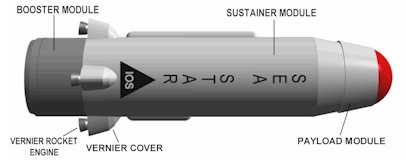
Home - Search - Browse - Alphabetic Index: 0- 1- 2- 3- 4- 5- 6- 7- 8- 9
A- B- C- D- E- F- G- H- I- J- K- L- M- N- O- P- Q- R- S- T- U- V- W- X- Y- Z
Sea Star

Sea Star
Credit: IOS
Status: Design 2005. Payload: 13 kg (28 lb). Apogee: 185 km (114 mi).
Sea Star MSLV was a stage-and-a-half design, similar to the older Atlas rockets, with a single large booster engine in a module attached to the aft end of the main structure-jettisoned during ascent-and four smaller vernier engines on the main structure. All the engines use liquid oxygen and liquid natural gas (LNG) as propellants. The main structures of the rocket, including the outer shell and propellant tanks, would use carbon composite materials. The vehicle was constructed for design simplicity.
Sea Star would not require land-based launch infrastructure. Taking advantage of design elements derived from submarine-launched ballistic missiles, this vehicle would float in seawater and launch directly from the ocean. IOS planned to launch Sea Star MSLV near California or in waters near the Kingdom of Tonga, with an initial launch planned for 2007.
LEO Payload: 13 kg (28 lb) to a 185 km orbit at 0.00 degrees.
Family: orbital launch vehicle, Sea-Launched. Country: USA. Agency: Interorbital Systems.
Back to top of page
Home - Search - Browse - Alphabetic Index: 0- 1- 2- 3- 4- 5- 6- 7- 8- 9
A- B- C- D- E- F- G- H- I- J- K- L- M- N- O- P- Q- R- S- T- U- V- W- X- Y- Z
© 1997-2019 Mark Wade - Contact
© / Conditions for Use